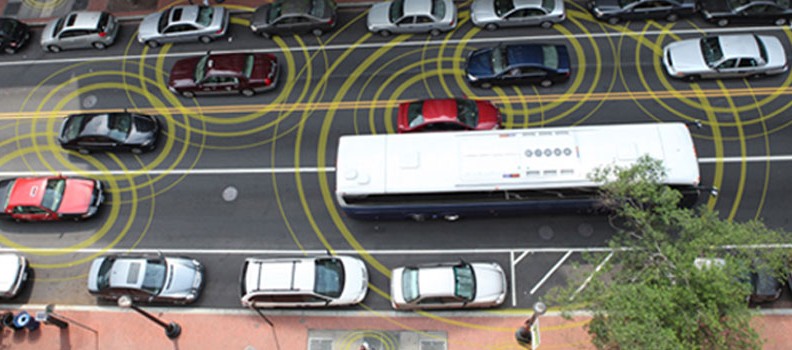Vehicle-to-Vehicle Communication – Challenges

Vehicle-to-vehicle communication (V2V) refers to automobiles’ ability to wirelessly share data with one another. The primary goal is to allow vehicles to communicate speed and position to help prevent collisions. Depending how this technology is used, the driver might simply be told they must brake now or risk an accident, or it may take more direct action to stop the event.
More and more devices are becoming connected through the cloud, an Internet-based system of software and services that can be accessed through a variety of methods. The future of the automotive industry is no exception, as slowly but surely cars will become connected. Connected cars made after 2010 usually include in-dash systems, an infotainment system or a head unit. Each of these systems could be connected on such a car:
- Music, Internet radio, devices connected to play music from your tablet or phone
- Navigation system, either built-in or using a phone
- Automotive system diagnosis, including computer service information or oil pressure
As with any Internet-enabled technology, connected cars can benefit from numerous advantages that come with V2V, but it also comes with its share of potential risks.
What is V2V/V2X?
It hasn’t been long since the connected car became commonplace, but the industry is still rapidly shaping up for a big change. This might just be thanks to the cloud becoming more commonplace.
While car manufacturers struggle to improve their connected cars, new technology has been making waves to improve security and privacy right from the beginning. This includes the short-range V2V wireless technology, as well as the longer-range vehicle-to-infrastructure system (V2I). V2X collectively refers to both of these as vehicle-to-everything. These technologies are strongly needed to prevent accidents.
What can these technologies bring? It’s estimated that 80 percent of accidents by unimpaired drivers can be prevented just by notifying the drivers of otherwise hidden dangers. Sharing data with a V2X-enabled car within a certain radius can alert a driver to areas that commonly cause accidents, warning to be careful.
The Future, Limitations and Restrictions
Estimates regarding the technology’s timeline range considerably, though the MIT Technology Review believed it would be widespread as early as next year. General Motors is already diving headfirst, intending to release a 2017 V2V Cadillac.
This connected network may prevent up to 80 percent of crashes that otherwise would occur with sober, healthy drivers; that adds up to 20,000 lives every year. However, there are still several challenges to overcome:
- Adding the technology to the car ups the cost by $250, though this is expected to lessen over time
- The benefits won’t really show until V2X vehicles are everywhere
- A secure system must be established and used to ensure privacy, authenticity and security of any and all V2X communication
The last point is especially a concern as security experts say that cyberattacks on motor vehicles wouldn’t be unheard of. Much like any computer, a car can be hacked; the only reason there hasn’t been a fatal hijacking is the fact the majority of cars aren’t connected with cellular lines, though this is changing rapidly.
Still, a wireless infotainment system doesn’t access your core steering controls — but the V2V program would change that. Once a hacker reaches the central computer, all bets are off. Consider these situations:
- Malware enters the car from the Web and a hacker takes control of the steering wheel
- A Wi-Fi traffic light tells your car it’s a different color than it’s showing, causing your car to behave inappropriately and collide
- The car swerves to prevent colliding with a nearby truck — but there wasn’t any truck, just a virus misinforming the computer
- Hackers access the highway grid system and force all cars to suddenly make a sharp turn while driving the speed limit
However unlikely the scenarios may seem, they are all real possibilities that stress the importance of stronger security.
Conclusion
Vehicle-to-vehicle communication can be a real game changer, especially as the government began mandating the technology just last year. Not all manufacturers are waiting for standards in the United States before taking advantage, however. Toyota stated it would use V2X technology with its 2016 vehicles as standards were already set in Japan, for example.
Clearly, it’s a major but controversial topic that will be resolved with time. Would you trust a vehicle with V2X technology yet? Or does it seem better to wait for more secure standards?
Cars Vehicle-to-Vehicle Communication. Photo by safercar.gov.
Would you like to receive similar articles by email?





